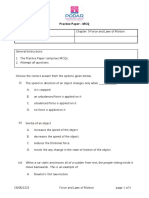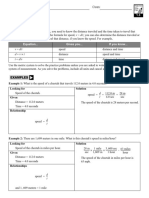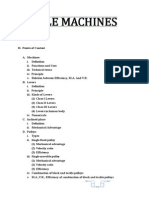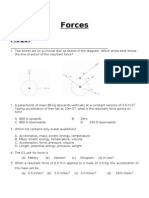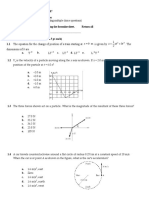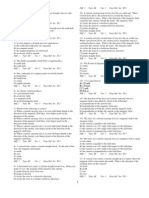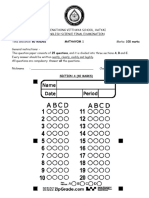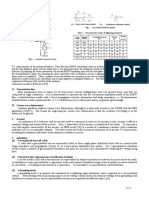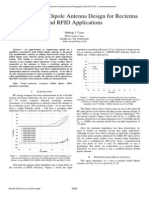Module 4 - WORK, ENERGY AND POWER
Module 4 - WORK, ENERGY AND POWER
Uploaded by
Hanah ArzCopyright:
Available Formats
Module 4 - WORK, ENERGY AND POWER
Module 4 - WORK, ENERGY AND POWER
Uploaded by
Hanah ArzOriginal Title
Copyright
Available Formats
Share this document
Did you find this document useful?
Is this content inappropriate?
Copyright:
Available Formats
Module 4 - WORK, ENERGY AND POWER
Module 4 - WORK, ENERGY AND POWER
Uploaded by
Hanah ArzCopyright:
Available Formats
WORK, ENERGY AND POWER
Physics for Engineers
Second Semester, S.Y. 2020-2021
MODULE IV
Course Code : Phys 123/121L
Course Title : Physics for Engineers (Lec/Lab)
Pre-requisite : Math 113, Math 123
Co-requisite : Math 113; Phys 121L
Credits Units : 4 units
Time Allotment : 6 hrs./week; 108 hours/semester
For this module : 1 week only
JUNDHEL D. CABRADILLA, REE
Instructor
1|Page Engr. Jundhel Cabradilla | SOE family - BiPSU
➢
This module covers basic concepts, principles, and history of physics. Course topic will
include topics in Vectors; kinematics; dynamics; work, energy, and power; impulse and
momentum; rotation; dynamics of rotation; elasticity; and oscillation. Fluids; thermal
expansion, thermal stress; heat transfer; calorimetry; waves; electrostatics; electricity;
magnetism; optics; image formation by plane and curved mirrors; and image formation by
thin lenses.
The students had to engage as an independent learner in this self-study designed
module. Also, the students had to familiarize themselves with the topics through the series
of explanations and examples given.
After this learning packet, the students will be able to:
- Distinguish between the common and technical definitions of work.
- Analyze how power is used and described in technical applications.
- Relate kinetic and potential energy to the law of conservation of mechanical
energy.
Students must submit their Answers to Pre-Test before the module release & submit their
answers to Post Assessment Test & of Culminating Activity on the date indicated at the
Google Classroom.
2|Page Engr. Jundhel Cabradilla | SOE family - BiPSU
➢
Acceleration – is a vector quantity that is defined as the rate at which an object changes
its velocity.
Dynamics – the study of the causes of motion and changes in motion.
Elasticity - is the ability of a body to resist a distorting influence and to return to its original
size and shape when that influence or force is removed.
Electricity - a form of energy resulting from the existence of charged particles (such as
electrons or protons), either statically as an accumulation of charge or dynamically as a
current.
Energy - is the capacity to do work.
Fluids - is a substance that continually deforms (flows) under an applied shear stress, or
external force.
Force - is a push or pull upon an object resulting from the object's interaction with another
object.
Impulse - is a quantity that describes the effect of a net force acting on an object (a kind
of "moving force").
Inertia - is the resistance of any physical object to any change in its velocity.
Kinematics – branch of classical mechanics that describes the motion of points, bodies
(objects) and systems of bodies (groups of objects) without consideration of the causes
of motion.
Magnetism – the study of physical phenomena that are mediated by magnetic field.
Momentum - is a quantity that describes an object's resistance to stopping (a kind of
"moving inertia").
Optics – the branch of physics which involves the behavior and properties of light,
including its interactions with matter and the construction of instruments that use or detect
it.
Oscillation - is defined as the process of repeating variations of any quantity or measure
about its equilibrium value in time.
Power - is the rate, per unit time, at which electrical energy is transferred by an electric
circuit.
Resistance - is a measure of the opposition to current flow in an electrical circuit.
Rotation - is a circular movement of an object around a center (or point) of rotation.
Scalar - is a quantity that can be completely described by a number (called its magnitude)
and a unit.
Vector - is a quantity that requires both magnitude (size) and direction to be completely
described.
Voltage - is the potential difference in charge between two points in an electrical field.
Wave - is a disturbance in a medium that carries energy without a net movement of
particles.
Work - measure of energy transfer that occurs when an object is moved over a distance
by an external force at least part of which is applied in the direction of the displacement.
3|Page Engr. Jundhel Cabradilla | SOE family - BiPSU
What is work? The common idea of the definition of work is quite different from the
technical definition. We often associate work with physical or mental effort that leads
to fatigue. The technical definition of work is more limited. If we try to lift a heavy
crate that does not budge [Fig. 8.1(a)], we would probably say that we have done
work because we strained our muscles and feel tired, but in a technical sense, no
work was done because the crate did not move. Work would be done on the crate if
we were to push it across the floor [Fig. 8.1(b)]. In this case, work was done by us,
and work was done on the crate.
Work is the product of the force in the direction of the motion and the displacement.
W = Fs
where:
W = work
F = force applied in the direction of the motion
s = displacement
4|Page Engr. Jundhel Cabradilla | SOE family - BiPSU
James P. Joule (1818–1889)
-physicist, was born in England. In a series of experiments from 1843 to 1878, he
showed that heat is a form of energy and established the mechanical equivalent of
heat, which formed the basis of the theory of the conservation of energy. He also
worked with Lord Kelvin on temperature changes in gases, which led to the founding
of the refrigeration industry. The unit of work, the joule, is named after him.
➢ Now, let us apply our technical definition of work to our unsuccessful effort to
lift the crate. We applied a force by lifting on the crate but were unable to
move it. Therefore, the displacement was zero, and the product of the force
and the displacement must also be zero. So, no work was done.
➢ From the equation for work, we can determine the units for work. In the metric
system, force is expressed in newtons and displacement in metres:
Work = force x displacement = Newton x meter = N m
➢ This unit (N m) has a special name in honor of James P. Joule.
1 N m = 1 Joule = 1 J
➢ In the U.S. system, force is expressed in pounds (lb) and displacement in feet
(ft):
work = force x displacement = pounds x feet = ft lb
➢ The U.S. unit of work is called the foot-pound.
➢ Work is not a vector quantity because it has no particular direction. It is a
scalar and has only magnitude.
Example 1:
Find the amount of work done by a worker lifting 225 N of bricks to a height of 1.75
m as shown in Figure below.
Data:
F = 225 N
s = 1.75 m
W=?
Basic Equation:
W = Fs
Substitution:
W = (225 N) (1.75 m)
= 394 Nm or 394 J
5|Page Engr. Jundhel Cabradilla | SOE family - BiPSU
Example 2:
A worker pushes a 350-lb cart a distance of 30 ft by exerting a constant force of 40
lb as shown in figure. How much work does the person do?
Data:
F = 40 lb
s = 30 ft
W=?
Basic Equation:
W = Fs
Substitution:
W = (40 lb) (30 ft)
= 1200 ft lb
Note: In Example 2 the cart weighs 350 lb but F = 40 lb. (Recall that the weight of an object
is the measure of its gravitational attraction to the earth and is represented by a vertical
vector pointing down to the center of the earth.) There is no vertical motion in the direction
of the gravitational force. Therefore, the weight of the box is not the force used to determine
the amount of work being done.
Work is being done by the worker pushing the pallet. Exerting a force of 40 lb results in a
displacement in the direction of the applied force. The work done is the product of this force
(40 lb) and the displacement (30 ft) in the direction the force is applied.
Recall that the definition of work states that work is the product of the force in the direction
of the motion and the displacement. To determine the work when the force is not applied in
the direction of the motion, consider a block being pulled by a rope with a force F that makes
an angle with level ground as shown in Fig. 8.6. First, draw the horizontal component Fx and
complete the right triangle. Note that Fx is the force in the direction of the motion. From the
right triangle we have
𝒔𝒊𝒅𝒆 𝒂𝒅𝒋𝒂𝒄𝒆𝒏𝒕 𝒕𝒐 𝜽 𝑭𝒙
𝒄𝒐𝒔 𝜽 = = 𝒐𝒓 𝑭𝒙 = 𝑭 𝒄𝒐𝒔 𝜽
𝒉𝒚𝒑𝒐𝒕𝒆𝒏𝒖𝒔𝒆 𝑭
That is, when the applied force is not in the direction of the motion, the work done is
𝑾 = 𝑭𝒔 𝒄𝒐𝒔 𝜽
Where: W = the work done
F = the applied force
s = the displacement
𝜽 = the angle applied force and the direction of the motion
6|Page Engr. Jundhel Cabradilla | SOE family - BiPSU
Example 3:
A person pulls a sled along level ground a distance of 15.0 m by exerting a constant
force of 215 N at an angle of 30.0° with the ground. How much work does she do?
Data:
F = 215 N
s = 15.0 m
θ = 30.00
W=?
Basic Equation:
W = 𝑭𝒔 𝒄𝒐𝒔 𝜽
Substitution:
W = (215 N) (15.0 m) cos 30.0o
= 2790 Nm or 2790 J
Example 4:
Juan and Sonja use a push mower to mow a lawn. Juan, who is taller, pushes at a
constant force of 33.1 N on the handle at an angle of 55.0° with the ground. Sonja,
who is shorter, pushes at a constant force of 23.2 N on the handle at an angle of
35.0° with the ground. Assume they each push the mower 3000m. Who does more
work and by how much?
Data:
F = 33.1 N F = 23.2 N
s = 3000 m s = 3000 m
θ = 55.00 θ = 35.00
W=? W=?
Basic Equation:
W = 𝑭𝒔 𝒄𝒐𝒔 𝜽 W = 𝑭𝒔 𝒄𝒐𝒔 𝜽
Substitution:
W = (33.1 N) (3000 m) cos 55.0o W = (23.2 N) (3000 m) cos 35.0o
= 57,000 Nm or 57,000 J = 57,000 Nm or 57,000 J
They do the same amount of work. However, Juan must exert more energy because he pushes
into the ground more than Sonja, who pushes more in the direction of the motion.
7|Page Engr. Jundhel Cabradilla | SOE family - BiPSU
Power is the rate of doing work; that is,
𝑾
𝑷=
𝒕
where:
P = Power
W = Work
t = time
➢ the unit of power is the Watt.
𝑾 𝑭𝒔 𝑵𝒎 𝑱
𝑷= = = = = 𝑾𝒂𝒕𝒕
𝒕 𝒕 𝒔 𝒔
➢ Power is often expressed in kilowatts and megawatts:
1,000 watts (W) = 1 kilowatt (kW)
1,000,000 watts = 1 megawatt (MW)
➢ In the U.S. system, the unit of power is either ft lb/s or horsepower:
𝑾 𝑭𝒔 𝒇𝒕 𝒍𝒃
𝑷= = =
𝒕 𝒕 𝒔
➢ Horsepower (hp) is a unit defined by James Watt:
1 horsepower (hp) = 550 lb ft/s = 33,000 ft lb/min
James Watt (1736–1819),
- engineer and inventor, was born in Scotland. He made fundamental improvements
to steam engines and is credited for several related inventions. The term horsepower
was first used by him; the SI unit of power, the watt, is named after him.
Example 1:
A freight elevator with operator weighs 5000 N. If it is raised to a height of 15.0 m in
10.0s, how much power is developed?
Data:
F = 5000 N
s = 15.0 m
t = 10.0 s
P=?
Basic Equation:
𝑾
𝑷= 𝒂𝒏𝒅 𝑾 = 𝑭𝒔
𝒕
Substitution:
𝐹𝑠 (5000 𝑁)(15.0𝑚) 𝑵𝒎
𝑃= = = 𝟕𝟓𝟎𝟎 𝒐𝒓 𝑾𝒂𝒕𝒕𝒔
𝑡 10.0 𝑠 𝒔
8|Page Engr. Jundhel Cabradilla | SOE family - BiPSU
Example 2:
The power expended in lifting an 825-lb girder to the top of a building 100 ft high is
10.0 hp. How much time is required to raise the girder?
Data:
F = 825 lb
s = 100 ft
P = 10.0 hp
t=?
Basic Equation:
𝑾
𝑷= 𝒂𝒏𝒅 𝑾 = 𝑭𝒔
𝒕
Substitution:
𝑾 𝑭𝒔 (𝟖𝟐𝟓 𝒍𝒃)(𝟏𝟎𝟎 𝒇𝒕) 𝟏𝒉𝒑
𝒕= = = 𝒙( 𝒍𝒃 ) = 𝟏𝟓𝒔
𝑷 𝑷 𝟏𝟎.𝟎 𝒉𝒑 𝟓𝟓𝟎𝒇𝒕
𝒔
Example 3:
The mass of a large steel wrecking ball is What power is used to raise it to a height
of 40.0 m if the work is done in 20.0 s?
Data:
m = 2000 kg
s = 40 m
t = 20 s
P=?
Basic Equation:
𝑾
𝑷= 𝒂𝒏𝒅 𝑾 = 𝑭𝒔
𝒕
Substitution:
𝑭𝒔
𝑷=
𝒕
F = mg = (2000kg) (9.8m/s²) = 19,600 kg m/s² = 19,600N
𝑭𝒔 (19,600𝑁)(40𝑚) 𝑁𝑚
𝑷= = = 39,200 = 39,200𝑊 = 𝟑𝟗. 𝟐 𝒌𝑾
𝒕 20𝑠 𝑠
9|Page Engr. Jundhel Cabradilla | SOE family - BiPSU
Example 4:
A machine is designed to perform a given amount of work in a given amount of
time. A second machine does the same amount of work in half the time. Find the
power of the second machine compared with the first.
Data: (for the second machine given in terms of the first):
W=W
𝟏 𝒕
𝒕= 𝒕=
𝟐 𝟐
P=?
Basic Equation:
𝑾
𝑷= 𝒕
Substitution:
𝑾 𝟐 𝑾
𝑷= 𝒕 = 𝑾 𝒙 = 𝟐( ) = 𝟐𝑷
𝒕 𝒕
𝟐
Example 5:
A pump is needed to lift 1500 L of water per minute a distance of 45.0 m. What
power, in kW, must the pump be able to deliver? (1 L of water has a mass of 1 kg.)
Data:
1kg
m = 1500 L x = 1,500 kg
1L
s = 45.0 m
t = 1 min = 60.0 s
g = 9.81 m/s2
P=?
Basic Equation:
𝑾 𝒎𝒈𝒔
𝑷= , 𝑾 = 𝑭𝒔 𝒂𝒏𝒅 𝑭 = 𝒎𝒈, 𝒐𝒓 𝑷 =
𝒕 𝒕
Substitution:
𝑚
𝑾 (1500𝑘𝑔)(9.8 𝑠 2 )(45𝑚)
𝑷= =
𝒕 60𝑠
𝑘𝑔 𝑚²
𝑷 = 1.10 𝑥 104
𝑠
1𝑘𝑊
𝑷 = 1.10 𝑥 104 𝑊 𝑥 3 = 11.0 𝑘𝑊
10 𝑊
10 | P a g e Engr. Jundhel Cabradilla | SOE family - BiPSU
➢ Energy is defined as the ability to do work. There are many forms of energy,
such as mechanical, electrical, thermal, fluid, chemical, atomic, and sound
(acoustic) energy.
➢ The mechanical energy of a body or a system is due to its position, its
motion, or its internal structure. There are two kinds of mechanical energy:
potential energy and kinetic energy.
➢ Potential energy is the stored energy of a body due to its internal
characteristics or its position.
➢ Kinetic energy is the energy due to the mass and the velocity of a moving
object.
➢ Internal potential energy is determined by the nature or condition of the
substance; for example, gasoline, a compressed spring, or a stretched rubber
band has internal potential energy due to its internal characteristics.
➢ Gravitational potential energy is determined by the position of an object
relative to a particular reference level; for example, a rock lying on the edge
of a cliff, the raised counterweight on an elevator ( Fig. 8.10), or a raised pile
driver has potential energy due to its position.
➢ Each weight has the ability to do work because of the pull of gravity on it. The
unit of energy is the joule (J) in the metric system and the foot-pound (ft lb)
in the U.S. system.
➢ Gravitational potential energy is measured by multiplying the weight of an
object (mass times acceleration of gravity) times the height of the object
relative to a particular reference level. So the work done in raising the object
a distance h is mgh, or W = Fs = mgh.
➢ The formula for gravitational potential energy is:
Ep = mgh
Where: Ep = potential energy
m = mass
g = 9.81 m/s2 or 32.2 ft/s2
h = height above reference level
11 | P a g e Engr. Jundhel Cabradilla | SOE family - BiPSU
Example 1:
A wrecking ball of mass is poised 4.00 m above a concrete platform whose top is
2.00 m above the ground. (a) With respect to the platform, what is the potential
energy of the ball? (b) With respect to the ground, what is the potential energy of
the ball?
Data:
m = 200 kg
h1 = 4.00 m
h2 = 6.00 m
Ep = ?
Basic Equation:
Ep = mgh
Substitution:
𝑚
a. 𝐸𝑝 = (200 𝑘𝑔) (9.81 2 ) ( 4.00 𝑚) = 7,840 𝐽
𝑠
= 7,840 J (which also indicates the amount of work done by gravity
on a falling object)
𝑚
b. 𝐸𝑝 = (200 𝑘𝑔) (9.81 2 ) ( 6.00 𝑚) = 11,800 𝐽
𝑠
12 | P a g e Engr. Jundhel Cabradilla | SOE family - BiPSU
Kinetic energy is due to the mass and the velocity of a moving object and is
given by the formula
𝟏
𝑬𝒌 = 𝟐 𝒎𝒗𝟐
where Ek = kinetic energy
m = mass of moving object
v = velocity of moving object
Example 2:
A pile driver with mass 10,000 kg strikes a pile with velocity 10.0 m/s. (a) What is
the kinetic energy of the driver as it strikes the pile? (b) If the pile is driven 20.0 cm
into the ground, what force is applied to the pile by the driver as it strikes the pile?
Assume that all the kinetic energy of the driver is converted to work.
Data:
m = 1.00 x 104 kg
v = 10.0 m/s
s = 20.0 cm = 0.200 m b. Basic Equation:
F=? 𝑬𝒌 = 𝑾 = 𝑭𝒔
a. Basic Equation: Working Equation:
𝐸
𝟏
𝑬𝒌 = 𝟐 𝒎𝒗𝟐 𝐹 = 𝑠𝑘 [Use 𝐸𝑘 from part (a)]
Substitution: Substitution:
1 𝑚 2 5.00 𝑥 105 𝐽 1𝑁 𝑚
𝐸𝑘 = (1.00 𝑥 10 4
𝑘𝑔) (10.0 𝑠 ) 𝐹= 𝑥
2 0.200 𝑚 1𝐽
= 5. 00 𝑥 105 J or 500 kJ = 2.50 𝑥 106 𝑁
13 | P a g e Engr. Jundhel Cabradilla | SOE family - BiPSU
Example 3:
A 60.0-g bullet is fired from a gun with 3150 J of kinetic energy. Find its velocity.
Data:
𝐸𝑘 = 3150 𝐽
𝑚 = 60.0 𝑔 = 0.060 𝑘𝑔
𝑣 = ?
Basic Equation:
𝟏
𝑬𝒌 = 𝟐 𝒎𝒗𝟐
Working Equation:
2𝐸𝑘
𝑣=√
𝑚
Substitution:
2(3150 𝐽) 1 𝑘𝑔 𝑚2 /𝑠 2
𝑣=√ 𝑥
0.060 𝑘𝑔 1𝐽
1 J =1 N m = 1 (kg m/s2) (m) = 1 kg m2/s2
𝒗 = 𝟑𝟐𝟒 𝒎/𝒔
14 | P a g e Engr. Jundhel Cabradilla | SOE family - BiPSU
The sum of the kinetic energy and the potential energy in a system is constant if no resistant
forces do work.
A pile driver shows this energy conservation. When the driver is at its highest position,
the potential energy is maximum and the kinetic energy is zero [Fig. 8.13(a)]. Its potential
energy is
𝑬𝒑 = 𝒎𝒈𝒉
and its kinetic energy is
𝟏 𝟏
𝑬𝒌 = 𝒎𝒗𝟐 = 𝒎(𝟎)𝟐 = 𝟎
𝟐 𝟐
When the driver hits the top of the pile [Fig. 8.13(b)], it has its maximum kinetic energy;its
potential energy is
𝑬𝒑 = 𝒎𝒈𝒉 = 𝒎𝒈 (𝟎) = 𝟎
Since the total energy in the system must remain constant, the maximum potential energy
must equal the maximum kinetic energy:
𝒎𝒂𝒙 𝑬𝒑 = 𝒎𝒂𝒙 𝑬𝒌
𝟏
𝒎𝒈𝒉 = 𝒎𝒗²
𝟐
Solving for the velocity of the driver as it hits the pile when the initial velocity of the driver
is zero gives
𝒗 = √𝟐𝒈𝒉
where: v = velocity
g = 9.80 m/s² or 32.2 ft/s²
h = height above the reference level
15 | P a g e Engr. Jundhel Cabradilla | SOE family - BiPSU
Example 1:
A pile driver falls freely from a height of 3.50 m above a pile. What is its velocity as it hits
the pile?
Data:
ℎ = 3.5 𝑚
𝑔 = 9.80 𝑚/𝑠²
𝑣 = ?
Basic Equation:
𝒗 = √𝟐𝒈𝒉
Substitution:
𝑣 = √2(9.80𝑚/𝑠²)(3.50𝑚)
𝒗 = 𝟖. 𝟐𝟖 𝒎/𝒔
16 | P a g e Engr. Jundhel Cabradilla | SOE family - BiPSU
Alternative energy is defined as a source of energy that does not originate from fossil
fuels and does not produce significant undesirable by products that could harm the
environment. Alternative energy sources include, but are not limited to, hydroelectric, wind,
geothermal, and solar energy.
➢ Hydroelectric energy takes advantage of flowing water to generate electricity.
Dams built to create reservoirs have a control gate that opens toward the bottom of
the dam. The escaping water spins a series of turbine blades that are connected to
electrical generators. The generators create electrical energy that is distributed
throughout the electrical power grid.
➢ Wind energy is used to generate electricity in much the same manner that flowing
water is utilized in hydroelectric power plants (Fig. 8.18). In the case of wind, giant
windmill-like fan blades rotate and are connected to electrical generators that convert
the kinetic energy of the turning fan blades into useful electrical energy. More and
more windfarms are being established in windy land areas and offshore sites.
➢ Geothermal energy takes advantage of the intense heat from the earth’s molten
core to heat underground water reservoirs. Drilling into these underground reservoirs
allows steam to escape and be directed into turbines that generate electricity that
can be distributed to consumers.
➢ Solar energy uses the sun’s light and a series of silicone-based solar arrays to create
electrical energy (Fig 8.19). The generated electrical energy is stored in a series of
batteries that can be distributed as electrical power when needed by the electrical
device that is connected to the battery. Solar energy is often used to provide
electricity for small and remote electrical devices such as streetlights, navigational
shipping lights, and orbiting satellites. Some power companies also allow their
consumers to place solar panels on their roofs. Consumers can then sell the excess
electricity they generate back to the power company.
17 | P a g e Engr. Jundhel Cabradilla | SOE family - BiPSU
Glossary:
Energy = The ability to do work. There are many forms of energy, such as mechanical,
electrical, thermal, fluid, chemical, atomic, and sound.
Gravitational Potential Energy = The energy determined by the position of an
object relative to a particular reference level.
Internal Potential Energy = The energy determined by the nature or condition of a
substance.
Kinetic Energy = The energy due to the mass and the velocity of a moving object.
Law of Conservation of Mechanical Energy = The sum of the kinetic energy and
the potential energy in a system is constant if no resistant forces do work.
Potential Energy = The stored energy of a body due to its internal characteristics or
its position.
Power = The rate of doing work (work divided by time).
Work = The product of the force in the direction of motion and the displacement.
Formulas:
𝑊 = 𝐹𝑠
𝑊 = 𝐹𝑠 𝑐𝑜𝑠𝜽
𝑊
𝑃=
𝑡
𝐸𝑃 = 𝑚𝑔ℎ
1
𝐸𝑘 = 𝑚𝑣²
2
𝑣 = √2𝑔ℎ
18 | P a g e Engr. Jundhel Cabradilla | SOE family - BiPSU
❖Suggested Readings
➢ Applied Physics - 10th Edition by Ewen, D., Schurter, N., & Gundersen, P.
E. (2012)
➢ College Physics – 9th Edition by Raymond A. Serway and Chris Vuille
For inquiries, you may call or text and chat:
ENGR. JUNDHEL D. CABRADILLA
Contact: 09751070490
Email address: engr.juncab@gmail.com
Facebook account: Engr. JC
19 | P a g e Engr. Jundhel Cabradilla | SOE family - BiPSU
20 | P a g e Engr. Jundhel Cabradilla | SOE family - BiPSU
You might also like
- Worksheet # 7 - Free Body DiagramDocument2 pagesWorksheet # 7 - Free Body DiagramyabalabahiyaNo ratings yet
- Lesson 1 - Introduction To Physics and MeasurementDocument12 pagesLesson 1 - Introduction To Physics and MeasurementHanah ArzNo ratings yet
- Past Perfect Continuous Exercise 5Document1 pagePast Perfect Continuous Exercise 5dilfuzanormatova402No ratings yet
- CHAPTER 6-6.2 Solving System of Equation Using Gaussian & Gauss Jordan (Part 1) - 440Document12 pagesCHAPTER 6-6.2 Solving System of Equation Using Gaussian & Gauss Jordan (Part 1) - 440Mugiwara LuffyNo ratings yet
- LP Energy BasicsDocument6 pagesLP Energy BasicsJedNo ratings yet
- Physic WorksheetDocument82 pagesPhysic WorksheetJohn Lower100% (1)
- Sentences & ClausesDocument11 pagesSentences & Clauseskyubiahri1306No ratings yet
- Speed, Velocity, and Acceleration ProblemsDocument1 pageSpeed, Velocity, and Acceleration ProblemsSarveshrau MagentharauNo ratings yet
- CB - IX - Sci - CH 9 Force and Laws of Motion - MCQDocument4 pagesCB - IX - Sci - CH 9 Force and Laws of Motion - MCQAARAV STAVYANo ratings yet
- Speed Problems ADocument4 pagesSpeed Problems ADamar CaesasuraNo ratings yet
- Expressing Agreement and Disagreement: Stating An OpinionDocument4 pagesExpressing Agreement and Disagreement: Stating An OpinionNadira AliyarahNo ratings yet
- Worksheet For WorkDocument3 pagesWorksheet For Workreielleceana07No ratings yet
- Simple MachinesDocument36 pagesSimple MachinesShrimohan MaheshwariNo ratings yet
- P2 Energy ReviseDocument6 pagesP2 Energy ReviseSamuel ChenNo ratings yet
- Bacteriological Analytical ManualDocument4 pagesBacteriological Analytical Manuallabfkm arsipNo ratings yet
- Reading QuizDocument8 pagesReading QuizAbdelrahman HishamNo ratings yet
- เฉลยชีทเสริมTPAT3Document15 pagesเฉลยชีทเสริมTPAT3Chayodom Vongbunsin TeeNo ratings yet
- Free Body Diagram WorksheetDocument6 pagesFree Body Diagram WorksheetAshleigh JarrettNo ratings yet
- Pulley-Test - FINAL 01-19-10Document11 pagesPulley-Test - FINAL 01-19-10Henok AmdiyeNo ratings yet
- Free-Body Diagrams and ForcesDocument17 pagesFree-Body Diagrams and Forcesapi-260547045No ratings yet
- Unit 4: Dynamics: Newton's Laws of MotionDocument22 pagesUnit 4: Dynamics: Newton's Laws of MotionDandy H HerkoNo ratings yet
- Net Force: Physics 11 M. Lam Name: BlockDocument2 pagesNet Force: Physics 11 M. Lam Name: Block700spymaster007No ratings yet
- Physics Core WorkbookDocument146 pagesPhysics Core WorkbookjreallsnNo ratings yet
- WS6 IG I Chemistry BEHAVIOUR OF METALSDocument4 pagesWS6 IG I Chemistry BEHAVIOUR OF METALSRaj MalkanNo ratings yet
- 05 - Integration Log Rule and Exponentials PDFDocument2 pages05 - Integration Log Rule and Exponentials PDFCamden GregoryNo ratings yet
- Relative ClausesDocument2 pagesRelative ClausesMaría SanzNo ratings yet
- Mid Test Practice Physics 7th Grade 2nd SemesterDocument7 pagesMid Test Practice Physics 7th Grade 2nd SemesterWilliam RyandinataNo ratings yet
- Newton's Law of MotionDocument33 pagesNewton's Law of Motionpedagogy.grdNo ratings yet
- Projectile Motion EDEXCELDocument16 pagesProjectile Motion EDEXCELThoon Nadi NaiNo ratings yet
- Speed and Velocity: Circular and Satellite Motion NameDocument1 pageSpeed and Velocity: Circular and Satellite Motion NameAnthony QuanNo ratings yet
- PHET Magnetism - Lab Grade: NameDocument4 pagesPHET Magnetism - Lab Grade: NameAyhan AbdulAzizNo ratings yet
- Newton WorksheetDocument7 pagesNewton WorksheetjparkteachNo ratings yet
- Take Home WorksheetDocument3 pagesTake Home WorksheetXu ShennaNo ratings yet
- 9-2 Reading Answers1Document4 pages9-2 Reading Answers1adalinefallingstarNo ratings yet
- Ch.3 Forces and Motion WorksheetDocument4 pagesCh.3 Forces and Motion WorksheetShahroze AhmedNo ratings yet
- Excretion and Waste Management TestDocument5 pagesExcretion and Waste Management Testapi-635512040No ratings yet
- แนวข้อสอบเข้า ม.4 ชุดที่ 2Document6 pagesแนวข้อสอบเข้า ม.4 ชุดที่ 2อลงกรณ์ แซ่ตั้งNo ratings yet
- Lesson Plan: Atomic PhysicsDocument5 pagesLesson Plan: Atomic Physics985wtz8rcjNo ratings yet
- Turning Effect of ForcesDocument6 pagesTurning Effect of Forcesbriannamuham1249No ratings yet
- Grade 2 - SentencesDocument12 pagesGrade 2 - Sentencesnhan199No ratings yet
- Materials Quiz and Properties AnswersDocument3 pagesMaterials Quiz and Properties AnswersSamantha AshmanNo ratings yet
- Separating MixturesDocument4 pagesSeparating MixturesRoxette RoseteNo ratings yet
- 1-D Momentum ConservationDocument3 pages1-D Momentum ConservationAshir Saif100% (1)
- Al 22 Equilibrium of ForcesDocument10 pagesAl 22 Equilibrium of ForcesSenuja ChammithaNo ratings yet
- Conservation of Momentum Using PASCO TM Carts and Track To Study Collisions in One DimensionDocument24 pagesConservation of Momentum Using PASCO TM Carts and Track To Study Collisions in One DimensionmemeawNo ratings yet
- Exercise 1-Merged PDFDocument59 pagesExercise 1-Merged PDFDev PuriNo ratings yet
- PressureDocument5 pagesPressureVikramNo ratings yet
- Final Exam W07Document5 pagesFinal Exam W07Malik ANo ratings yet
- Saint Gabriel's College Social Studies (Geography) Secondary 1 Name Surname .. Class M.1/ No..Document2 pagesSaint Gabriel's College Social Studies (Geography) Secondary 1 Name Surname .. Class M.1/ No..ApichayaNo ratings yet
- Social m1 PDFDocument2 pagesSocial m1 PDFApichayaNo ratings yet
- Work Power Energy PDFDocument38 pagesWork Power Energy PDFKrizzi Dizon GarciaNo ratings yet
- CH - 20 Magnetism WorksheetDocument7 pagesCH - 20 Magnetism WorksheetAna BegovacNo ratings yet
- Final End 2-Mathayom 1 ScienceDocument8 pagesFinal End 2-Mathayom 1 ScienceAbdullohNo ratings yet
- I Wish If OnlyDocument2 pagesI Wish If OnlyPili BonaminoNo ratings yet
- Past Perfect Continuous Exercise 1Document1 pagePast Perfect Continuous Exercise 1CharmaineNo ratings yet
- Mechanical Properties of FluidsDocument33 pagesMechanical Properties of FluidsManas ThakurNo ratings yet
- Chapter No 2 Scalars and VectorsDocument14 pagesChapter No 2 Scalars and VectorsRizwan KhanNo ratings yet
- 03 GravitationDocument16 pages03 GravitationPankaj BudhaniNo ratings yet
- General Physics 1Document31 pagesGeneral Physics 1Ali aliraqiNo ratings yet
- Work (Physics)Document15 pagesWork (Physics)Alfredo RomeroNo ratings yet
- Work (Physics) : Etymology Units Work and Energy Constraint Forces Mathematical CalculationDocument14 pagesWork (Physics) : Etymology Units Work and Energy Constraint Forces Mathematical CalculationBenjamin KonjicijaNo ratings yet
- Module 5 - IMPULSE, MOMENTUM and COLLISIONDocument21 pagesModule 5 - IMPULSE, MOMENTUM and COLLISIONHanah Arz100% (1)
- Module 2 - Vector and ScalarDocument23 pagesModule 2 - Vector and ScalarHanah ArzNo ratings yet
- Module 9 - Wave Motion and SoundDocument27 pagesModule 9 - Wave Motion and SoundHanah ArzNo ratings yet
- Module 8 - Temperature, Heat Quantities and Heat TransferDocument22 pagesModule 8 - Temperature, Heat Quantities and Heat TransferHanah ArzNo ratings yet
- Module 4 Draw 113Document28 pagesModule 4 Draw 113Hanah ArzNo ratings yet
- Voltmeter Usage: Parts and MaterialsDocument43 pagesVoltmeter Usage: Parts and Materialsjun dee100% (2)
- Analysis of Series, Parallel, Series-Parallel Circuits: Chapter - 3Document71 pagesAnalysis of Series, Parallel, Series-Parallel Circuits: Chapter - 3shimieNo ratings yet
- Brushless DC Motor Control With: C868 and Capcom6Document55 pagesBrushless DC Motor Control With: C868 and Capcom6Hung Nguyen HuyNo ratings yet
- Symbols in Physics WorksheetDocument4 pagesSymbols in Physics WorksheetHugh Fox IIINo ratings yet
- Circuit Analysis PDFDocument618 pagesCircuit Analysis PDFMustaghfiri Asror100% (1)
- Scotch YokeDocument2 pagesScotch YokeJay Mark Parayno100% (1)
- Solar Tracking SystemDocument56 pagesSolar Tracking Systemvijay AmirtharajNo ratings yet
- Estimating Electrical Power Demand in Buildings - Steven McFadyenDocument51 pagesEstimating Electrical Power Demand in Buildings - Steven McFadyennhatvp100% (1)
- Student Support Material Class XII PhysicsDocument115 pagesStudent Support Material Class XII PhysicscsmsrivathsanNo ratings yet
- DC-to-DC Power Converter by Rodney Yeu and Sudip Kundu ECE 345 Section H TA: Jon Wheeler 4/26/02 Project #34Document22 pagesDC-to-DC Power Converter by Rodney Yeu and Sudip Kundu ECE 345 Section H TA: Jon Wheeler 4/26/02 Project #34Harkishen SinghNo ratings yet
- G. Transmission LineDocument16 pagesG. Transmission LineJosNo ratings yet
- 77C 61000-2-13 High Power Transient Phenomena 77C/125/CD, 77C/132/CCDocument33 pages77C 61000-2-13 High Power Transient Phenomena 77C/125/CD, 77C/132/CCmitaNo ratings yet
- Power Cable TestingDocument34 pagesPower Cable TestingManoj Kumar PadmanabanNo ratings yet
- Lateral Analysis of Piles User Manual: James - Doherty@uwa - Edu.auDocument74 pagesLateral Analysis of Piles User Manual: James - Doherty@uwa - Edu.auKuntal GhoshNo ratings yet
- Printed Folded Dipole Antenna Design For RectennaDocument4 pagesPrinted Folded Dipole Antenna Design For RectennaMohamed Hussien HamedNo ratings yet
- ABL8BBU24200: Product Data SheetDocument6 pagesABL8BBU24200: Product Data SheetAlexandre ThorelNo ratings yet
- Puc Ii PhysicsDocument1 pagePuc Ii PhysicsChinmay SultanpuriNo ratings yet
- Shell Momentum Balance and Velocity Distribution in Laminar Lec2 2.4-2.5Document29 pagesShell Momentum Balance and Velocity Distribution in Laminar Lec2 2.4-2.5Al- DhaheriNo ratings yet
- Fuzzy Logic Controller Based On Voltage Source Converter-Hvdc SystemDocument7 pagesFuzzy Logic Controller Based On Voltage Source Converter-Hvdc SystemBhuvneshRathoreNo ratings yet
- Acoustics and Architecture PDFDocument358 pagesAcoustics and Architecture PDFBhavikMistryNo ratings yet
- WaqarDocument33 pagesWaqarWaqar AhmadNo ratings yet
- Amp GardDocument40 pagesAmp GardRoberto Andrés AlvarezNo ratings yet
- General Physics 1Document15 pagesGeneral Physics 1Dainielle Marie PascualNo ratings yet
- Cutler-Hammer ATS Parts ManualDocument70 pagesCutler-Hammer ATS Parts ManualTom LeonardNo ratings yet
- HW2 Solutions PDFDocument12 pagesHW2 Solutions PDFpaTriciaNo ratings yet
- CW2106 SpecsDocument2 pagesCW2106 SpecsBob HwknsNo ratings yet
- NTPC - Industrial Training ReportDocument84 pagesNTPC - Industrial Training ReportMd Khalid Akhtar100% (1)
- Module 5 - Generation of High VoltageDocument48 pagesModule 5 - Generation of High VoltageFah RukhNo ratings yet
- Different Types of Bus Bar ArrangementDocument18 pagesDifferent Types of Bus Bar ArrangementRajeshRaman67% (3)
- Topic I - Paper - 6Document7 pagesTopic I - Paper - 6karunamcsNo ratings yet








